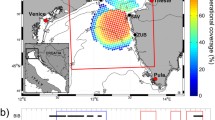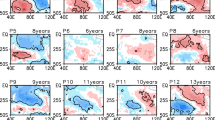Abstract
The tropical Indian Ocean climate variability is investigated using an artificial neural network analysis called self-organizing map (SOM) for both observational data and coupled model outputs. The SOM successfully captures the dipole sea surface temperature anomaly (SSTA) pattern associated with the Indian Ocean Dipole (IOD) and basin-wide warming/cooling associated with ENSO. The dipole SSTA pattern appears only in boreal summer and fall, whereas the basin-wide warming/cooling appears mostly in boreal winter and spring owing to the phase-locking nature of these phenomena. Their occurrence also undergoes significant decadal variation. Composite diagrams constructed for nodes in the SOM array based on the simulated SSTA reveal interesting features. For the nodes with the basin-wide warming, a strong positive SSTA in the eastern equatorial Pacific, a negative Southern Oscillation, and a negative precipitation anomaly in East Africa are found. The nodes with the positive IOD are associated with a weak positive SSTA in the central equatorial Pacific or positive SSTA in the eastern equatorial Pacific, a positive (negative) sea level pressure anomaly in the eastern (western) tropical Indian Ocean, and a positive precipitation anomaly over East Africa. The warming in the central equatorial Pacific appears to correspond to El Niño Modoki discussed recently. These results suggest usefulness of SOM in studying large-scale ocean–atmosphere coupled phenomena.












Similar content being viewed by others
References
Allan NJ, Chambers D, Drosdowsky W, Hendon H, Latif M, Nicholls N, Smith I, Stone R, Tourre Y (2001) Is there an Indian Ocean Dipole, and is it independent of El Niño-Southern Oscillation? CLIVAR Exch 6:18–22
An SI, Ye Z, Hsieh WW (2006) Changes in the leading ENSO modes associated with the late 1970s climate shift: role of surface zonal current. Geophys Res Lett 33: doi:10.1029/2006GL026604
Annamalai H, Murtugudde R (2004) Role of the Indian Ocean in regional climate variability. In Earth’s climate: the ocean–atmosphere interaction. Geophys Monogr Ser 147:213–211
Ashok K, Guan Z, Yamagata T (2001) Impact of the Indian Ocean Dipole on the decadal relationship between the Indian monsoon rainfall and ENSO. Geophys Res Lett 28:4499–4502
Ashok K, Behera SK, Rao SA, Weng H, Yamagata T (2007) El Niño-Modoki and its possible teleconnections. J Geophys Res 112: doi:10.1029/2006JC003798
Behera SK, Yamagata T (2003) Influence of the Indian Ocean Dipole on the Southern Oscillation. J Meteor Soc Japan 81:169–177
Behera SK, Rao SA, Saji HN, Yamagata T (2003) Comments on “A cautionary note on the interpretation of EOFs”. J Clim 16:1087–1093
Behera SK, Luo JJ, Masson S, Delecluse P, Gualdi S, Navarra A, Yamagata T (2005) Paramount impact of the Indian Ocean Dipole on the East African short rains: a CGCM study. J Clim 18:4514–4530
Black E, Slingo J, Sperber KR (2003) An observational study of the relationship between excessively strong short rains in coastal East Africa and Indian Ocean SST. Mon Wea Rev 131:74–94
Chang P, Yamagata T, Schopf P, Behera SK, Carton J, Kessler WS, Meyers G, Qu T, Schott F, Shetye S, Xie SP (2006) Climate fluctuations of tropical coupled systems-The role of ocean dynamics. J Clim 19:5122–5174
Cheng P, Wilson RE (2006) Temporal variability of vertical nontidal circulation pattern in a partially mixed estuary: comparison of self-organizing map and empirical orthogonal functions. J Geophys Res 111: doi:10.1029/ 2005JC003241
Collins DC, Reason CJC, Tangang F (2004) Predictability of Indian Ocean sea surface temperature using canonical correlation analysis. Clim Dyn 22:481–497
Dommenget D, Latif M (2002) A cautionary note on the interpretation of EOFs. J Clim 15:216–225
Guan Z, Yamagata T (2003) The unusual summer of 1994 in East Asia: IOD teleconnections. Geophys Res Lett 30: doi:10.1029/2002GL016831
Gualdi S, Guilyardi E, Navarra A, Masina S, Delecluse P (2003) The interannual variability in the tropical indian ocean as simulated by a coupled GCM. Clim Dyn 20:567–582
Klein SA, Soden BJ, Lau NC (1999) Remote sea surface temperature variations during ENSO: evidence for a tropical atmospheric bridge. J Clim 12:917–932
Kohonen T (1982) Self-organized information of topologically correct features maps. Biol Cybern 43:59–69
Kohonen T (2001) Self-organizing maps. 3rd edn. Springer, Berlin, p 501
Kohonen T, Hynninen J, Kangas J, Laaksonen J (1995) SOM_PAK, The self-organizing map program package version 3.1, Laboratory of Computer and Information Science, Helsinki University of Technology, Finland, 27 pp
Leloup JA, Lachkar Z, Boulanger JP, Thiria S (2007a) Detecting decadal changes in ENSO using neural networks. Clim Dyn 28:147–162
Leloup JA, Lengaigne M, Boulanger JP (2007b) Twentieth century ENSO characteristics in the IPCC database. Clim Dyn: doi:10.1007/s00382-007-0284-3
Liu Y, Weisberg RH, Mooers CNK (2006) Performance evaluation of the self-organizing map for feature extraction. J Geophys Res 111: doi:10.1029/2005JC003117
Luo JJ, Masson S, Behera SK, Gualdi S, Navarra A, Delecluse P, Yamagata T (2003) South Pacific source of the decadal ENSO-like variation as reproduced by a coupled GCM. Geophys Res Lett 30: doi:10.1029/2003GL018649
Madec G, Delecluse P, Imbard M, Levy C (1998) OPA version 8.1 ocean general circulation model reference manual. Tech Rep/Note, 11: LODYC/IPSL, Paris, 91 pp
North GR, Bell LT, Cahalan RF (1982) Sampling errors in the estimation of empirical orthogonal functions. Mon Wea Rev 110:699–706
Rayner NA, Parker DE, Horton EB, Folland CK, Alexander LV, Rowell DP, Kent EC, Kaplan A (2003) Global analysis of SST, sea ice and night marine air temperature since the late nineteenth century. J Geophys Res 108: doi:10.1029 /2002JD002670
Richardson AJ, Risien C, Shillington FA (2003) Using self-organizing maps to identify patterns in satellite imagery. Prog Oceanogr 59:223–239
Roeckner E et al (1996) The atmospheric general circulation model ECHAM4: model description and simulation of present day climate. Max-Plank Institute fur Meteorologie Rep 218: Hamburg, 90 pp
Saji NH, Yamagata T (2003) Possible impacts of Indian Ocean Dipole events on global climate. Clim Res 25:151–169
Saji NH, Goswami BN, Vinayachandran PN, Yamagata T (1999) A dipole mode in the tropical Indian Ocean. Nature 401:360–363
Tozuka T, Luo JJ, Masson S, Behera SK, Yamagata T (2005) Annual ENSO simulated in a coupled ocean–atmosphere model. Dyn Atmos Ocean 39:41–60
Tozuka T, Luo JJ, Masson S, Yamagata T (2007) Decadal modulations of the Indian Ocean Dipole in the SINTEX-F1 coupled GCM. J Clim 20:2881–2894
Valcke S, Terray L, Piacentini A (2000) The OASIS coupler user guide version 2.4. Tech Rep TR/CMGC/00–10, CERFACS, Toulouse, p 85
Vecchi GA, Harrison DE (2004) Interannual Indian rainfall variability and Indian Ocean sea surface temperature anomalies. In Earth’s climate: the ocean–atmosphere interaction. Geophys Monogr Ser 147:247–259
Walker GT (1924) Correlations in seasonal variations of weather. IX Mem India Meteorol Dep 24:275–332
Webster PJ, Moore A, Loschnigg J, Leban M (1999) Coupled ocean-atmosphere dynamics in the Indian Ocean during 1997–98. Nature 401:356–360
Weng H, Ashok K, Behera SK, Rao SA, Yamagata T (2007) Impacts of recent El Niño Modoki on dry/wet conditions in the Pacific rim during boreal summer. Clim Dyn 29:113–129
Wu A, Hsieh WW (2003) Nonlinear interdecadal changes of the El Niño-Southern Oscillation. Clim Dyn 21:719–730
Yamagata T, Behera SK, Luo J-J, Masson S, Jury MR, Rao SA (2004) Coupled ocean-atmosphere variability in the tropical Indian Ocean. In Earth’s climate: The ocean-atmosphere interaction. Geophys Monogr Ser 147:189–211
Acknowledgments
This study is benefited from discussions with Dr. S. K. Behera and Dr. I. Iskandar. Constructive comments from three reviewers helped us to improve our manuscript. We are indebted to Dr. R. Zhang for data management. The SINTEX-F1 model was run on the Earth Simulator. The SOM_PAK software was provided by the Neural Network Research Centre at the Helsinki University of Technology and is available at http://www.cis.hut.fi/research/som_pak. The present research is supported by the 21st century COE grant from the Ministry of Education, Culture, Sports, Science, and Technology of Japan for the “Predictability of the Evolution and Variation of the Multi-scale Earth System: An Integrated COE for Observational and Computational Earth Science” of the University of Tokyo, and the Japan Society for Promotion of Science through Grant-in-Aid for Scientific Research (A) 17204040.
Author information
Authors and Affiliations
Corresponding author
Appendix
Appendix
To examine whether SOM and EOF can capture two climate modes with the same variance, we have generated an artificial SSTA data by
Here, pc1(t) and pc2(t) are the first two normalized principal components, and EOF1(x, y) and EOF2(x, y) are the normalized eigenfunctions or spatial patterns of the first two EOF modes of the tropical Indian Ocean shown in Fig. 12a. Note that we made the random noise noise(x,y,t) to contribute to about 10% of the total variance and each of the first two modes explains about 45% of the total variance as they are normalized.
When the SOM method is applied to this data, an SOM array, which is very similar to Fig. 2, is obtained (figure not shown). However, as is clear from Fig. 13, the EOF method failed to capture the original SSTA pattern for the first two modes shown in Fig. 12. The first EOF mode in Fig. 13 has a larger SSTA in the southeastern tropical Indian Ocean, whereas that in Fig. 12a has a larger SSTA in the west. We note that this mixture occurs even when more than three modes have a similar variance and rotated EOF could not provide a remedy for this particular problem (see also Behera et al. 2003). A similar pitfall was also met by Dommenget and Latif (2002).
Rights and permissions
About this article
Cite this article
Tozuka, T., Luo, JJ., Masson, S. et al. Tropical Indian Ocean variability revealed by self-organizing maps. Clim Dyn 31, 333–343 (2008). https://doi.org/10.1007/s00382-007-0356-4
Received:
Accepted:
Published:
Issue Date:
DOI: https://doi.org/10.1007/s00382-007-0356-4





